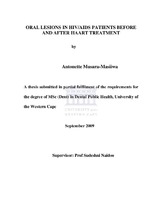| dc.description.abstract | The initiation of highly active antiretroviral therapy has shown to result in successful
suppression of viral replications followed by an increase in CD4 lymphocytes, a partial recovery of T-cell specific immune responses and decrease susceptibility to opportunistic pathogens. Aim: The aim of the present study was to determine the prevalence of oral lesions in patients before and after undergoing HAART. Methods: The study design was longitudinal and descriptive, investigating the prevalence of oral lesions presenting in HIV/AIDS patients at baseline, 3 and 6 months after taking HAART. A convenience sample size of 200 participants was targeted. Results: 210 HIV positive patients participated at baseline. At 3 months, 96 (46%) and at 6 months, 52 (25%) were available for review respectively. At baseline 210 HIV positive patients were recruited into the study from three hospitals. Two infectious disease hospitals belonged to the City of Harare and the other is a government hospital. Just over two thirds were female (64.3%) and the age ranged as follows: 21-30 (17%); 31-40 (44%); 41-50 (26% and 51-60 (9%).Discussion: HAART appears to be effective in reducing the prevalence of oral lesions in
persons with AIDS likely due to the immunological reconstitution. Oral candidiasis
remains the most prevalent oral opportunistic infection in immuno-suppressed individuals and hence its important predictive value for immuno-suppression defined as CD4-cell count level <200/mL of blood. All oral lesions strongly associated with HIV infection with the exception of non-Hodgkin’s lymphoma were diagnosed at baseline. CD4 cell count level increased after initiation of HAART. T-lymphocytes that are formed after the introduction of HAART may not provide sufficient protection against some lesions like parotid gland disease and HPV conditions (planar warts). HAART failure was detected in some patients who had negative CD4-cell count at 6 months compared to the baseline parameters. Conclusions: HIV-positive patients experience oral pain during the course of
their disease, eating, drinking and swallowing. Further longitudinal studies are required in order to ascertain the prevalence of these lesions at three and six months and the effect of HAART. | en_US |

